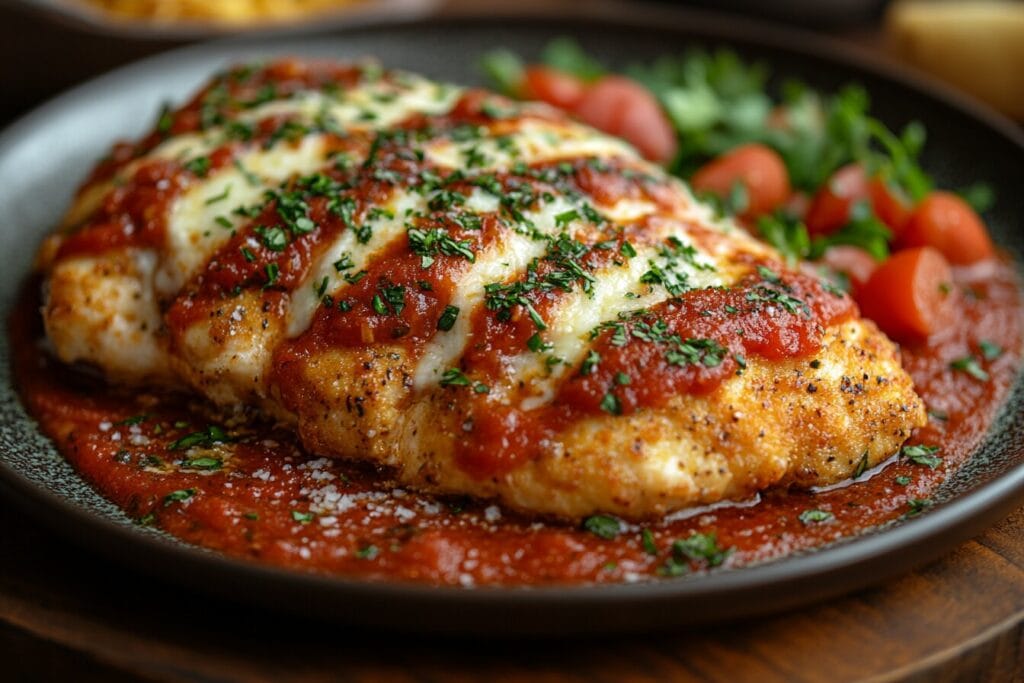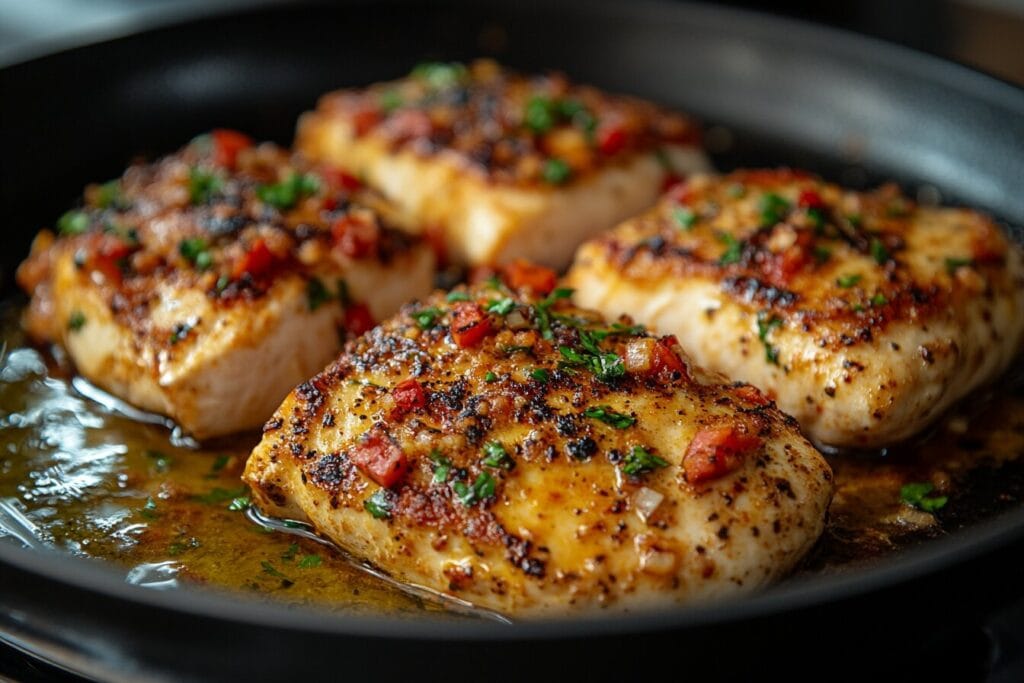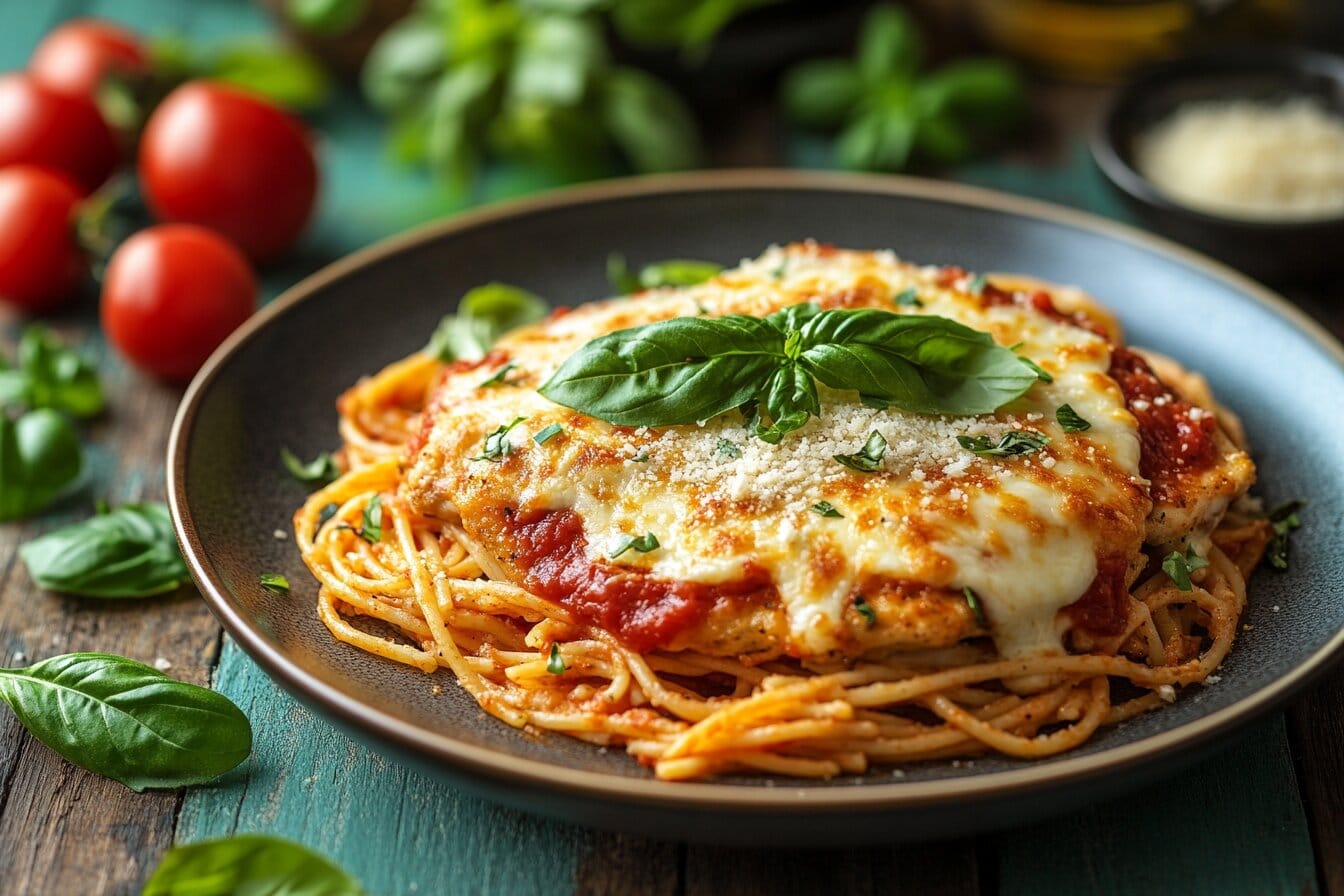If you’re a fan of Italian food (and let’s be honest, who isn’t?), you’ve probably encountered the two delicious names: Chicken Parmigiana and Parmesan cheese. But what exactly is the difference between these two? At first glance, they seem similar, especially since Parmesan cheese plays a starring role in Chicken Parmigiana. However, there are some important distinctions that set them apart. Let’s dive into the world of these iconic Italian dishes and ingredients, and uncover their unique characteristics!
Table of Contents
Introduction:
Italian cuisine is known for its bold flavors, simple ingredients, and rich history. When it comes to iconic dishes like Chicken Parmigiana and Parmesan cheese, both have earned their spot in kitchens around the world. These two are beloved for their savory taste, but they represent different aspects of Italian food. Chicken Parmigiana is a mouthwatering dish that blends breaded, fried chicken with marinara sauce and, of course, Parmesan cheese. On the other hand, Parmesan is a hard, aged cheese that has a distinctive nutty and salty flavor.
In this article, we’ll explore the origin, preparation methods, and key differences between these two to help you understand why they are so often confused. Let’s start with Chicken Parmigiana.
Chicken Parmigiana: An Overview of This Classic Dish
The Origins of Chicken Parmigiana
Chicken Parmigiana, often referred to as “Chicken Parmesan” in some places, is one of those comfort foods you can’t go wrong with. But have you ever wondered where it comes from? Its origins are actually Italian-American, not strictly Italian. While Italy does have many delicious meat dishes, Chicken Parmigiana as we know it today was created by Italian immigrants in the United States in the early 20th century. The dish is an adaptation of a traditional Italian recipe called “Melanzane alla Parmigiana,” which involves layers of fried eggplant, marinara sauce, and Parmesan cheese.
As Italian immigrants settled in America, they began using chicken instead of eggplant to create a more meat-based version of the dish. The use of Parmesan and mozzarella cheese, along with the marinara sauce, created a comforting meal that quickly became a favorite across the U.S.
Key Ingredients in Chicken Parmigiana
Chicken Parmigiana is a beautifully simple dish, but it’s packed with flavor! The key ingredients include:
- Chicken Breast: The chicken is breaded and fried until crispy, providing a crunchy base for the cheese and sauce.
- Marinara Sauce: A rich, tomato-based sauce seasoned with garlic, basil, and oregano.
- Parmesan Cheese: This is the cheese you’ll sprinkle over the chicken, giving it a sharp, nutty flavor.
- Mozzarella Cheese: A softer, meltier cheese that blankets the chicken, making it gooey and delicious.
The combination of these ingredients creates a balanced dish that’s both crispy and tender, tangy and cheesy, and absolutely irresistible.
How Chicken Parmigiana is Prepared and Served
Chicken Parmigiana is a dish that’s incredibly easy to prepare and serve. You start by breading chicken breasts and frying them until golden brown. Then, you smother the chicken in marinara sauce, sprinkle on the Parmesan cheese, and top it all off with a generous layer of mozzarella cheese. The dish is then baked in the oven to melt the cheese and create a bubbling, golden crust.
While the classic Chicken Parmigiana is often served over pasta, you can also serve it alongside a salad, on a sandwich, or even on its own. It’s a versatile dish that can be enjoyed in so many ways, making it a staple in many households.

Parmesan Cheese: What Makes It Special?
The History and Origin of Parmesan Cheese
Now let’s shift gears and focus on the cheese that’s often a key player in Chicken Parmigiana: Parmesan. But what makes Parmesan cheese so special? The name “Parmesan” refers to Parmigiano-Reggiano, a hard, Italian cheese that’s been produced for centuries. Originating in the regions of Parma, Reggio Emilia, Modena, and others in Northern Italy, Parmesan has a rich history that dates back to the Middle Ages.
What makes Parmesan unique is its traditional production process. It’s made from cow’s milk and is aged for at least 12 months, although the best varieties are aged for 24 months or more. The cheese develops a granular texture and a complex, nutty, and salty flavor profile during its aging process. The longer it’s aged, the more intense the flavor becomes.
Types of Parmesan Cheese (Parmigiano Reggiano vs. Others)
While Parmigiano-Reggiano is the “real” Parmesan, you might encounter other varieties of Parmesan that aren’t technically the same. Parmigiano-Reggiano is a protected cheese with strict regulations regarding its production, and it can only be produced in certain regions of Italy. Any other cheese that’s called “Parmesan” is technically not the same and is often made outside of Italy, usually in countries like the U.S. and Argentina. These cheeses are often younger and may not have the same depth of flavor as the original Parmigiano-Reggiano.
To make sure you’re getting the real deal, look for the official “Parmigiano-Reggiano” label or check the markings on the rind, which typically indicate the region it comes from. When choosing Parmesan for your Chicken Parmigiana, authentic Parmigiano-Reggiano will give your dish the best taste.
How Parmesan is Made and Its Unique Flavor Profile
Making Parmesan cheese is a long, meticulous process that takes time and skill. The milk is heated, combined with rennet (an enzyme), and left to curdle. Afterward, the curds are cut into small pieces and cooked in hot water. This helps to develop the cheese’s firm texture and unique flavor.
The cheese is then aged in temperature-controlled rooms for anywhere from 12 to 36 months, during which it loses moisture and develops its characteristic hard, crumbly texture. The result is a rich, salty, nutty cheese with an intense flavor that can add depth to a variety of dishes—especially your Chicken Parmigiana!
Key Differences Between Chicken Parmigiana and Parmesan
The Role of Chicken in Parmigiana vs. the Use of Parmesan
Now, here’s the big question: What exactly sets Chicken Parmigiana and Parmesan apart? The most obvious difference is the chicken itself. Chicken Parmigiana is a hearty dish made with breaded, fried chicken, while Parmesan is a type of cheese used as an ingredient in many dishes, including Chicken Parmigiana.
While Chicken Parmigiana features chicken as the centerpiece of the dish, Parmesan cheese is typically used as a topping or an integral part of the recipe. In other words, Parmesan is an ingredient, while Chicken Parmigiana is a full meal!
Cooking Methods: Baked vs. Grated
Another key difference is how each is prepared. Chicken Parmigiana is baked after being breaded and fried, allowing the cheese to melt and create that gooey, delicious layer on top. On the other hand, Parmesan cheese is typically grated or shaved and used to top dishes like pastas, salads, and yes, even Chicken Parmigiana. The cheese can also be eaten on its own or added to sauces and soups. The methods of preparation really highlight the different ways these two elements of Italian cuisine are enjoyed. 🍳
Flavor Profiles: Savory Chicken vs. Aged, Nutty Cheese
When it comes to flavor, there’s a big difference between the two. Chicken Parmigiana has a savory, crispy, and tender flavor, thanks to the breaded chicken and the rich marinara sauce. The cheese adds a salty, creamy component, but the chicken is the star of the show.
In contrast, Parmesan cheese has an aged, nutty, and sharp flavor that can be both rich and complex. Parmesan is often used as a finishing touch to elevate a dish, providing a burst of umami that enhances the overall flavor.
Nutritional Differences: Chicken Parmigiana vs. Parmesan
Nutritionally, these two are quite different as well. Chicken Parmigiana, being a main dish, is higher in calories and protein due to the chicken and the breading. Parmesan, on the other hand, is a cheese with high fat content but also a good source of calcium and protein in small quantities.
Here’s a quick comparison of their nutritional facts:
Nutritional Comparison (per serving):
| Nutrient | Chicken Parmigiana (1 serving) | Parmesan Cheese (1 oz) |
|---|---|---|
| Calories | 400-500 | 110 |
| Protein | 35g | 10g |
| Carbs | 20g | 1g |
| Fat | 20g | 7g |
| Sodium | 900mg | 200mg |
As you can see, Chicken Parmigiana is much higher in calories and fat, but it also provides more protein, thanks to the chicken. Parmesan cheese is lower in calories but is still nutrient-rich in smaller amounts.
Common Confusions and Misconceptions About These Two Dishes
It’s easy to get a bit mixed up between Chicken Parmigiana and Parmesan cheese, especially since one of them includes the other as an ingredient! So let’s clear up some of the most common misconceptions about these two Italian icons.

Is Chicken Parmigiana Made with Parmesan?
The short answer is yes—Chicken Parmigiana does use Parmesan cheese. But here’s the catch: Parmesan is just one part of the equation. Along with Parmesan, mozzarella cheese is also a key ingredient in Chicken Parmigiana. Parmesan typically goes on top, while mozzarella gives that gooey, melty texture you know and love.
It’s important to note that some recipes use other cheeses, but traditional Chicken Parmigiana always features at least Parmesan. So, next time you order this dish at a restaurant or make it at home, you can rest easy knowing that Parmesan is definitely involved.
Can Parmesan Be Used in Chicken Parmigiana?
Absolutely! Parmesan is not only an ingredient in Chicken Parmigiana, but it’s also a crucial component that gives the dish its signature sharp, nutty flavor. However, Parmesan alone doesn’t define the dish. If you only used Parmesan without any chicken or mozzarella, you’d end up with a very different dish!
Parmesan can also be sprinkled on top of a variety of other Italian dishes, from pastas to salads, to enhance the flavor. The versatility of Parmesan makes it an essential pantry staple for anyone who loves to cook Italian food.
Common Problems When Making Chicken Parmigiana and Their Solutions
Making Chicken Parmigiana might seem like a straightforward task, but there are a few hurdles you can encounter. Whether you’re cooking it for the first time or you’re a seasoned pro, here are some common issues and how to solve them.
Overcooking or Undercooking the Chicken
One of the most common problems when making Chicken Parmigiana is overcooking or undercooking the chicken. If you overcook the chicken, it can become dry and tough. If you undercook it, you run the risk of serving unsafe, raw chicken. Here’s how to avoid these problems:
- Solution: Use a meat thermometer to ensure the chicken reaches an internal temperature of 165°F (75°C). This will ensure your chicken is perfectly cooked—juicy on the inside and crispy on the outside. Also, make sure to fry the chicken for just enough time to get that golden brown crust before baking it in the oven to melt the cheese.
How to Avoid Soggy Chicken Parmigiana
Another issue many people face when preparing Chicken Parmigiana is soggy breading. If the chicken gets too wet before or during baking, the breading can become soft and unappealing.
- Solution: To prevent soggy breading, be sure to properly drain the fried chicken on a paper towel before adding the marinara sauce. If you’re preparing the dish ahead of time, you can also bake the chicken in advance without adding the sauce, allowing the breading to stay crispy. Add the sauce and cheese only when you’re ready to bake it for the final melt.
Balancing the Cheese and Sauce for Perfect Flavor
The balance between cheese and sauce is essential when making Chicken Parmigiana. Too much sauce can make the chicken soggy, while too little sauce can make the dish dry and bland.
- Solution: When preparing your Chicken Parmigiana, use a moderate amount of marinara sauce so that the chicken remains crispy while still getting that tangy, tomato flavor. The sauce should complement the cheese, not overwhelm it, so try to strike the right balance to keep the dish flavorful but not overly saucy. Remember, the cheese should be the star, so don’t go overboard with the marinara!
Tips for Perfecting Your Chicken Parmigiana at Home
Making Chicken Parmigiana at home can be a fun and rewarding experience. With a few tips, you can take your dish from good to great!
h3: Choosing the Right Chicken Cut for Parmigiana
The type of chicken you use can make all the difference in your Chicken Parmigiana. While boneless, skinless chicken breasts are commonly used, some people opt for thighs for a juicier, more flavorful cut. Each has its pros and cons:
- Chicken Breasts: They cook faster and are easy to slice into uniform pieces. However, they can dry out if overcooked.
- Chicken Thighs: These have more fat, which makes them juicier and more flavorful, but they can take longer to cook.
Choose whichever cut you prefer, but remember that thinner chicken pieces cook faster and allow for more even breading.
The Best Parmesan Cheese to Use for Chicken Parmigiana
When it comes to choosing Parmesan for your Chicken Parmigiana, always go for the real thing—Parmigiano Reggiano. The depth of flavor in this cheese can elevate the dish to another level.
However, if you’re in a pinch and don’t have access to authentic Parmigiano Reggiano, pre-grated Parmesan can work as a substitute. It won’t have the same complex flavor, but it will still add the salty, umami kick the dish needs. Always try to use freshly grated Parmesan for the best results.
How to Make Chicken Parmigiana Crispy and Golden
The key to a perfect Chicken Parmigiana lies in the crispy, golden crust. If you want your breading to stay crisp after baking, follow these steps:
- Dredge the Chicken: Coat the chicken in flour, egg, and breadcrumbs. The flour helps the egg stick, and the breadcrumbs give it that golden crunch.
- Fry the Chicken: Fry the chicken in hot oil, but don’t crowd the pan. Frying the chicken until it’s golden brown creates the perfect crunchy base.
- Bake the Chicken: After frying, bake the chicken with the marinara sauce and cheese. This final step ensures the cheese melts beautifully without making the crust soggy.
By following these simple steps, you can achieve a perfectly crispy and golden Chicken Parmigiana that’s the star of any meal. 🍽️
The Versatility of Parmesan: More Than Just for Chicken Parmigiana
Parmesan cheese isn’t just for Chicken Parmigiana! This versatile cheese can be used in so many different ways, making it a must-have in any kitchen.
Other Dishes That Benefit from Parmesan Cheese
While Chicken Parmigiana is probably the most famous dish featuring Parmesan, this cheese can be used in countless other recipes, such as:
- Pasta Dishes: Sprinkle Parmesan on top of spaghetti, fettuccine Alfredo, or lasagna to add a burst of flavor.
- Salads: Add Parmesan shavings to Caesar salads or any green salad to enhance the flavor.
- Soups: Parmesan is often used in soups like minestrone or tomato basil, where it melts into the broth for extra richness.
The possibilities are endless! Parmesan is a fantastic addition to nearly any savory dish.
Exploring Parmesan in Salads, Pastas, and More
One of the simplest ways to enjoy Parmesan is to pair it with pasta. Whether you’re making a rich Alfredo sauce, a simple spaghetti aglio e olio, or a hearty Bolognese, a sprinkle of Parmesan takes the dish from good to great. You can also use it in salads, on roasted vegetables, or even in a homemade pesto sauce. Parmesan adds a savory kick that enhances the flavors of whatever it touches.
Conclusion: Why Both Chicken Parmigiana and Parmesan Are Beloved
To wrap things up, let’s reflect on why Chicken Parmigiana and Parmesan cheese have become such beloved staples in kitchens around the world.
- Chicken Parmigiana is the perfect comfort food—crispy, cheesy, and satisfying. It’s versatile, easy to make, and can be enjoyed in various forms, whether over pasta or in a sandwich.
- Parmesan cheese, on the other hand, is an ingredient that transcends any single dish. Its nutty, salty flavor can elevate almost any meal, making it a culinary treasure.
Both Chicken Parmigiana and Parmesan have earned their place in the hearts (and stomachs) of food lovers everywhere. Whether you’re indulging in a cheesy plate of Chicken Parmigiana or sprinkling Parmesan on your pasta, these two Italian gems are here to stay!
That concludes our deep dive into the differences between Chicken Parmigiana and Parmesan! We’ve explored the origins, ingredients, and preparation methods of each, as well as common misconceptions and tips for making the perfect dish. Hopefully, you now have a clearer understanding of why these two culinary staples are so often confused—and why they’re both so irresistible!

